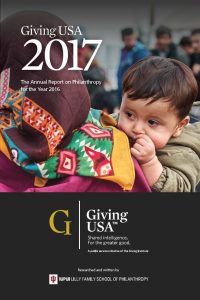OFFICIAL PRESS RELEASE
Giving by individuals grows nearly 4 percent, driving the rise in total giving; contributions to all nine major philanthropy subsectors increase—the sixth time in the last four decades.

American individuals, estates, foundations and corporations contributed an estimated $390.05 billion to U.S. charities in 2016, according to Giving USA 2017: The Annual Report on Philanthropy for the Year 2016, released today.
Total giving rose 2.7 percent in current dollars (1.4 percent adjusted for inflation) from the revised estimate of $379.89 billion for total giving in 2015. (Please see below for a more detailed breakdown of the numbers for each philanthropic source and sector.)
Giving USA, the longest-running and most comprehensive report of its kind in America, is published by Giving USA Foundation, a public service initiative of The Giving Institute. It is researched and written by the Indiana University Lilly Family School of Philanthropy.
Charitable giving from individuals, foundations and corporations all increased in 2016, while gifts by estates decreased sharply.
Giving to all nine major categories of recipient organizations grew, making 2016 just the sixth time in the past 40 years that this has occurred. The nine categories are religion; education; human services; giving to foundations; health; public-society benefit; arts, culture and humanities; international affairs; and environment and animals.
“This report tells us that Americans remained generous in 2016, despite it being a year punctuated by economic and political uncertainty,” said Aggie Sweeney, CFRE, chair of Giving USA Foundation and senior counsel at Campbell & Company. “We saw growth in every major sector, indicating the resilience of philanthropy and diverse motivations of donors.”
The rise in total giving was spurred largely by giving from individuals, which increased nearly 4 percent in 2016.
“Individual giving continued its remarkable role in American philanthropy in a year that included a turbulent election season that reflected a globally resurgent populism,” said Amir Pasic, Ph.D., the Eugene R. Tempel Dean of the Lilly Family School of Philanthropy. “In this context, the absence of a dramatic change in giving is perhaps remarkable, but it also demonstrates the need for us to better understand the multitude of individual and collective decisions that comprise our record of national giving.”
While the political climate may play a role in some donors’ decisions to give to charity, research conducted by the Indiana University Lilly Family School of Philanthropy and other philanthropy researchers has long demonstrated that aggregate giving trends are influenced by large-scale economic factors. These factors ultimately affect the economic and financial circumstances of all types of donors and, therefore, their ability to give.
As an example of the link between the economy and charitable giving trends, giving by individuals has historically correlated with changes in such national-level economic indicators as personal consumption, disposable personal income and the Standard & Poor’s 500 Index. All of these factors are associated with households’ permanent and long-term financial stability.
In 2016, helping to increase giving by individuals and households, both personal consumption and disposable personal income grew by nearly 4 percent over 2015. The S&P 500 finished the year up 9.5 percent after uneven performance for much of 2016 and a mixed economic picture in 2015.
“When compared with giving by individuals, corporate giving saw slightly more modest growth in 2016, at 3.5 percent,” said Jeffrey Byrne, Chair of The Giving Institute, and president and CEO of Jeffrey D. Byrne + Associates. “Corporate giving is significantly influenced by annual changes in pre-tax profits and Gross Domestic Product, which was up 3.0 percent, as compared with 3.7 percent in 2015 and 4.2 percent in 2014. Similarly, corporate pre-tax profits, which can be quite variable from year to year, grew 2.7 percent in 2016.”
Highlights about Giving by Source
- Giving by individuals grew at a higher rate than the other sources of giving, outpacing giving by foundations and by corporations, and offsetting the sharp decline in bequests.
- Giving by foundations rose more slowly in 2016 compared to the stronger increases seen in recent years, according to data provided by Foundation Center.
- Corporate giving increased modestly in 2016, in the wake of slower GDP growth and little movement in the share of pre-tax profits directed to giving.
- Giving by bequest fell sharply, following two years of strong growth. Gifts in the form of bequests frequently fluctuate from year to year and are less influenced by economic factors.
“In 2016, we saw something of a democratization of philanthropy,” said Patrick M. Rooney, Ph.D., associate dean for academic affairs and research at the Lilly Family School of Philanthropy. “The strong growth in individual giving may be less attributable to the largest of the large gifts, which were not as robust as we have seen in some prior years, suggesting that more of that growth in 2016 may have come from giving by donors among the general population compared to recent years.”
The Numbers for 2016 Charitable Giving by Source:
- Giving by individuals totaled an estimated $281.86 billion, rising 3.9 percent (2.6 percent adjusted for inflation) in 2016.
- Giving by foundations increased 3.5 percent (2.2 percent adjusted for inflation) to an estimated $59.28 billion in 2016. Data on foundation giving are provided by Foundation Center.
- Giving by bequest totaled an estimated $30.36 billion in 2016, declining 9.0 percent (10.1 percent adjusted for inflation) from 2015.
- Giving by corporations is estimated to have increased by 3.5 percent (2.3 percent adjusted for inflation) in 2016, totaling $18.55 billion.
New to this year’s edition of Giving USA is a special section on donor-advised funds, which provides analysis of major trends in both giving to and from these charitable vehicles.
Highlights about 2016 Gifts to Charitable Organizations
For the charitable organizations receiving contributions, 2016 was a year of growth across the board.
- Giving to all nine major types of charitable organizations increased in 2016.
- Education giving saw relatively slower growth (3.6 percent) compared to the strong growth rates experienced in most post-recession years. In each of the years 2014 and 2015 education giving grew by more than 8 percent.
- Giving to international affairs, human services and public-society benefit organizations all grew. This growth is in spite of relatively few widely publicized natural disasters, which often increase contributions to these types of organizations.
- Environment and animals charities; arts, culture and humanities organizations; international affairs nonprofits; and health causes experienced the largest jumps in contributions.
“In 2016, we saw a number of changes from patterns we have seen in recent years,” said Una Osili, Ph.D., director of research at the Indiana University Lilly Family School of Philanthropy. “While giving to arts, health and the environment experienced significant growth, giving to education saw relatively slower growth. In most years, giving to education, arts and culture and health organizations often experience similar changes in growth rates, but in 2016 arts and health giving are both notably higher than giving to education. Giving for international affairs also saw growth even though there were lower levels of giving for disaster relief.”
The Numbers for 2016 Charitable Giving to Recipients:
- Giving to religion increased 3.0 percent (1.8 percent adjusted for inflation), with an estimated $122.94 billion in contributions.
- Giving to education is estimated to have increased 3.6 percent (2.3 percent adjusted for inflation) to $59.77 billion.
- Giving to human services increased by an estimated 4.0 percent (2.7 percent adjusted for inflation), totaling $46.80 billion.
- Giving to foundations is estimated to have increased by 3.1 percent (1.8 percent adjusted for inflation), rising to $40.56 billion.
- Giving to health organizations is estimated to have increased by 5.7 percent (4.4 percent adjusted for inflation), to $33.14 billion.
- Giving to public-society benefit organizations increased by an estimated 3.7 percent (2.5 percent adjusted for inflation) to $29.89 billion.
- Giving to arts, culture, and humanities is estimated to have increased 6.4 percent (5.1 percent adjusted for inflation) to $18.21 billion.
- Giving to international affairs is estimated to be $22.03 billion in 2016, an increase of 5.8 percent (4.6 percent adjusted for inflation).
- Giving to environment and animal organizations is estimated to have increased 7.2 percent (5.8 percent adjusted for inflation) to $11.05 billion.
In addition, giving to individuals is estimated to have declined 2.5 percent (3.7 percent in inflation-adjusted dollars) to $7.12 billion. The bulk of these donations are in-kind gifts of medications to patients in need, made through the Patient Assistance Programs (PAPs) of pharmaceutical companies’ operating foundations.
Unallocated giving was negative $1.46 billion in 2016. This amount can be considered as the difference between giving by source and by use in any particular year. This amount includes the difference between itemized deductions by individuals (and households) carried over from previous years. The tax year in which a gift is claimed by the donor (carried over) and the year when the recipient organization reports it as revenue (the year in which it is received) may be different.
-30-
NOTES TO EDITORS
Members of the media can request 40-year data tables that show sources of contributions by year in current and inflation-adjusted dollars, and allocation of gifts by type of recipient category, also in current and inflation-adjusted dollars. Data also are available showing total giving as a percentage of GDP, individual giving as a percentage of disposable income and corporate giving as a percentage of corporate pre-tax profits.
The requested citation for Giving USA is Giving USA 2017: The Annual Report on Philanthropy for the Year 2016, a publication of Giving USA Foundation, 2017, researched and written by the Indiana University Lilly Family School of Philanthropy. Available online at www.givingusa.org.
About Giving USA Foundation
Advancing the research, education and public understanding of philanthropy is the mission of Giving USA Foundation, founded in 1985 by The Giving Institute. Headquartered in Chicago, the Foundation publishes data and trends about charitable giving through its seminal publication, Giving USA, and quarterly reports on topics related to philanthropy. Published since 1956, Giving USA is the longest running, most comprehensive report on philanthropy in America. Read more about Giving USA Foundation’s history, as well as the history of Giving USA and philanthropy in the U.S. in the Giving USA 2015 Spotlight: Celebrating Service to Philanthropy (available as a free download).
About Giving USA
For over 60 years, Giving USA: The Annual Report on Philanthropy in America, has provided comprehensive charitable giving data that are relied on by donors, fundraisers and nonprofit leaders. The research in this annual report estimates all giving to charitable organizations across the United States. Giving USA is a public outreach initiative of Giving USA Foundation and is researched and written by the Indiana University Lilly Family School of Philanthropy. Giving USA Foundation, established in 1985 by The Giving Institute, endeavors to advance philanthropy through research and education. Explore Giving USA products and resources, including free highlights of each annual report, at our online store.
About The Giving Institute
The Giving Institute, the parent organization of Giving USA Foundation, consists of member organizations that have embraced and embodied the core values of ethics, excellence and leadership in advancing philanthropy. Serving clients of every size and purpose, from local institutions to international organizations, The Giving Institute member organizations embrace the highest ethical standards and maintain a strict code of fair practices. For information on selecting fundraising counsel, visit www.givinginstitute.org.
How to Obtain Giving USA 2017
Giving USA 2017: The Annual Report on Philanthropy for the Year 2016 is available for download starting June 13 at www.givingusa.org. A complimentary executive summary, Highlights, also will be available on that date.
Customers can select from a number of Giving USA 2017 products, including the full report, available in both digital and paperback formats; a PowerPoint slide deck; data tables; and the free Highlights executive summary.
Giving USA Foundation periodically publishes in-depth reports (Special Reports) on different aspects of charitable giving and fundraising trends. Visit www.givingusa.org for available topics; prices vary.
About the Indiana University Lilly Family School of Philanthropy
The Indiana University Lilly Family School of Philanthropy is dedicated to improving philanthropy to improve the world by training and empowering students and professionals to be innovators and leaders who create positive and lasting change. The school offers a comprehensive approach to philanthropy through its academic, research, and international programs and through The Fund Raising School, Lake Institute on Faith & Giving and the Women’s Philanthropy Institute. For more information, visit philanthropy.iupui.edu.
Giving USA Methodology
Giving USA estimates primarily rely on econometric methods developed by leading researchers in philanthropy and the nonprofit sector and are reviewed and approved by members of the Giving USA Advisory Council on Methodology (ACM). Members of the ACM include research directors from national nonprofit organizations, as well as scholars from such disciplines as economics and public affairs, all of whom are involved in studying philanthropy and the nonprofit sector.
The Indiana University Lilly Family School of Philanthropy prepares all of the estimates in Giving USA for Giving USA Foundation. Giving USA develops estimates for giving by each type of donor (sources) and for recipient organizations categorized by subsectors (uses). Most of Giving USA’s annual estimates are based on econometric analyses and tabulations of tax data, economic indicators and demographics. Data for giving by foundations come from Foundation Center.
Following the same approach used by leading public and private institutions that develop economic statistics, Giving USA researchers update data found within Giving USA each year. This is because current Giving USA estimates are developed before final tax data, some economic indicators and some demographic data are available. The estimates are revised and updated as final versions of these data become available. Final estimates are usually developed two or three years after their initial release.
For more specific details on Giving USA’s methodology, please refer to the “Brief summary of methods” section within Giving USA 2017 or contact the Indiana University Lilly Family School of Philanthropy at [email protected] or 317-278-8972.


